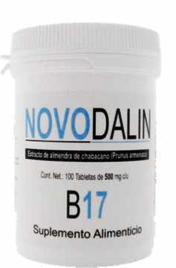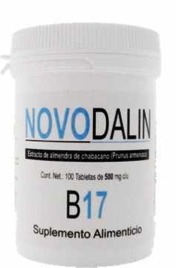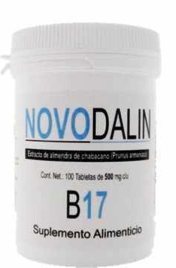So how does B17 kill cancer?....... Here we go....
Firstly we need to understand that our bodies use several enzymes to perform many tasks. Our body has one particular enzyme called Rhodanese which is found in large quantities throughout the body but is not present where ever there are cancer cells. Yet, where ever you find cancer in the body, you find another enzyme called Beta-Glucosidase. So, we have the enzyme Rhodanese found everywhere in the body except at the cancer cells, and we have the enzyme Beta-Glucosidase found in very large quantities only at the cancer cell but not found anywhere else in the body. If there is no cancer in the body there is no enzyme Beta-Glucosidase.
Now the following is what scares most people. You see, Vitamin B17 is made up of 2 parts glucose, 1 part Hydrogen Cyanide and 1 part Benzaldehyde(analgesic/painkiller). So its very important you understand the following:
When B17 is introduced to the body, it is broken down by the enzyme Rhodanese. The Rhodanese breaks the Hydrogen Cyanide and Benzaldehyde down into 2 by-products, Thiocyanate and Benzoic acid which are beneficial in nourishing healthy cells and forms the metabolic pool production for vitamin B12. Any excess of these by-products is expelled in normal fashion from the body via urine. Vitamin B17 passes through your body and does not last longer than 80 minutes inside your body as a result of the Rhodanese breaking it down. (Hydrogen Cyanide has been proven to be chemically inert and non toxic when taken as food or refined pharmaceutical such as laetrile. Sugar has be shown to be 20 times more toxic than B17 - see good & bad cyanide).
HERE IS THE GOOD PART - When the B17 comes into contact with cancer cells, there is no Rhodanese to break it down and neutrelise it but instead, only the enzyme Beta-Gucosidase is present in very large quantities. When B17 and Beta-Glucosidase come into contact with each other, a chemical reaction occurs and the Hydrogen Cyanide and Benzaldehyde combine synergistically to produce a poison which destroys and kills the cancer cells.
This whole process is known as selective toxicity. Only the cancer cells are specifically targeted and destroyed.
Good & Bad Cyanide?
This section addresses everything you wanted to know about the laetrile-cyanide connection. We all know that cyanide is bad for you, yet here we are jumping up and down saying its good for you because it kills cancer. Lets look at the real story.
This section assumes you read the previous section How does B17 kill Cancer.
Hydrogen Cyanide must be FORMED!! There is no free Hydrogen Cyanide in laetrile floating around freely in our body waiting to harm us when we eat apricot seeds or take laetrile. The enzyme Beta-Glucosidase, and only that enzyme is capable of manufacturing and forming the Hydrogen Cyanide from Laetrile.. If there are no cancer cells in the body, there is no beta-glucosidase. If there is no beta-glucosidase, no hydrogen cyanide will be formed from laetrile. Even if there were some other way to manufacture cyanide from laetrile in the body, the amount would be so minute it would have little, if any toxic effect. (see How does B17 kill Cancer?)
Laetrile does on the other hand contain the cyanide radical (CN-). So does Vitamin B12 , Cassava and strawberries and a host of other foods we consume. You never heard of anyone getting cyanide poison from vitamin B12 or from eating strawberries because it just does not happen. Lets also look at table salt which is made up of sodium Chloride (NaCl) and is very common in most households. Yet, did you know pure sodium (Na+) is one of the most toxic substances known to man? Yet in their form locked together they are not toxic. Any good toxicologist will tell you sugar is 20 times more toxic than laetrile and salt is also much more toxic.
Two rules of thumb: According to Dr. Krebs, the basic concept is that sufficient daily B-17 may be obtained by following either of two suggestions:
First, eating all the B-17-containing fruits whole (seeds included), but not eating more of the seeds by themselves than you would be eating if you ate them in the whole fruit. Example:
if you eat three apples a day, the seeds in the three apples are sufficient B-17. You would not eat a pound of apple seeds.
Second, one peach or apricot kernel per 10 lbs of body weight is believed to be more than sufficient as a normal safeguard in cancer prevention, although precise numbers may vary from person to person in accordance with individual metabolism and dietary habits. A 170-lb man, for example, might consume 17 apricot or peach kernels per day and receive a biologically reasonable amount of Vitamin B-17.
And two important notes: Certainly, you can consume too much of anything. Too many kernels or seeds, for example, can be expected to produce unpleasant side effects. These natural foods should be consumed in biologically rational amounts (no more than 30 to 35 kernels per day).
High concentrations of B-17 are obtained by eating the natural foods in their raw or sprouting stage. This does not mean that moderate cooking and other tampering will destroy the B-17 content. Foods cooked at a temperature sufficient for a Chinese dinner, for example, will not lose their B-17 content.
Foods Containing B17 (Nitrilosides)
Vitamin B17 appears in abundance in untamed nature. Because B17 is bitter to the taste, in man's attempt to improve tastes and flavors for his own pleasure, he has eliminated bitter substances like B17 by selection and cross-breeding. It can be stated as a general rule that many of the foods that have been domesticated still contain the vitamin B17 in that part not eaten by modem man, such as the seeds in apricots. Listed below is an evaluation of some of the more common foods. Keep in mind that these are averages only and that specimens vary widely depending on variety, locale, soil, and climate. SOURCE: The Little Cyanide Cookbook by June de Spain - (former) FDA Toxicologist and Pharmacologist.
Home | Products | Video | References & Links | Nitrilosides | F.A.Q. | About Us | Contact Us | Sitemap












